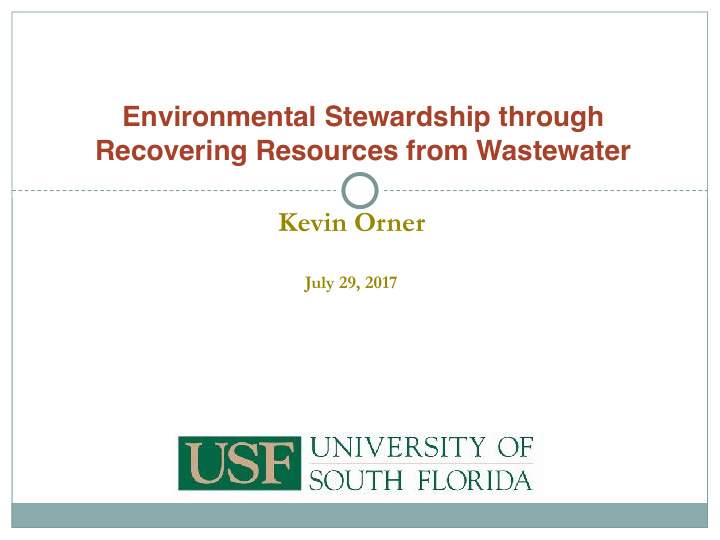



Environmental Stewardship through Recovering Resources from Wastewater Kevin Orner July 29, 2017
Overview ▪ About Me ▪ Introduction ▪ Current Research ▪ Future Research ▪ Conclusion
Overview ▪ About Me ▪ Introduction ▪ Current Research ▪ Future Research ▪ Conclusion
About Me Madison, WI 2004-2008, 2011-2014 Tampa, FL 2008-2009, 2014-present
About Me Panama 2009-2011 Costa Rica 2018
Overview ▪ About Me ▪ Introduction ▪ Current Research ▪ Future Research ▪ Conclusion
Where does it go?
What’s in wastewater? Stuff includes… •Feces •Pathogens •Nutrients •Cleaning products •Medications •Kitchen waste
Why is wastewater a problem?
Sanitation looks different in other places
Sanitation looks different in other places
Introduction Sustainable Development Goals
Introduction 2.4 billion still lack access to sanitation 280,000 diarrheal deaths occur annually from inadequate sanitation 35% reduction in diarrheal deaths with improved sanitation
Introduction Old paradigm: Removal Wastewater as waste NEW paradigm: Recovery Wastewater as resource N: Nutrients E: Energy W: Water
Introduction Creation Care: Genesis 2:15: To serve and to protect Psalm 19:1: The sky above proclaims his handiwork Take what was considered a waste, with no value, and see its purpose
Overview ▪ About Me ▪ Introduction ▪ Current Research ▪ Urban ▪ Rural ▪ Future Research ▪ Conclusion
Current Research-Urban Nutrient Management In a Sewershed Building = Urine Community = Sewer Mining City = Anaerobic Digestion, Struvite Precipitation (Orner et al., Environmental Engineering Science, 2017)
Current Research-Urban (Orner et al., Environmental Engineering Science, 2017)
Current Research-Urban
Current Research-Urban Struvite Precipitation MgNH4PO4 Recovers ~90% P, ~20% N What to do with remaining N?
Current Research-Urban Microbial Fuel Cells entered our field about 10-15 years ago Bacteria mediate oxidation-reduction reactions, therefore electrons are being transferred
Overall Objective: Build and assess the performance of a microbial fuel cell that both removes ammonium and provides energy. Supernatant from anaerobic Microbial digestion: “Digestate” Fuel Cell High concentrations of N, ● P Usually recycled back into ● the main treatment stream “Sidestream”
Microbial Fuel Cell Setup
Microbial Fuel Cell Setup
Data Collection Ammonium and phosphate recovery during struvite precipitation.
Data Collection Total Nitrogen Recovery and Removal (mg/L TN) in struvite reactor influent, struvite reactor effluent, nitrification effluent, and cathodic effluent.
Overview ▪ About Me ▪ Introduction ▪ Current Research ▪ Urban ▪ Rural ▪ Future Research ▪ Conclusion
Current Research-Rural
Data Collection
Overview ▪ About Me ▪ Introduction ▪ Current Research ▪ Future Research ▪ Conclusion
Future Research Stage 1: Laboratory Setup Analyze Microbial Community Stage 2: Demonstration at Hillsborough County Northwest Facility
Future Research Stage 3: Fulbright Research Grant to Costa Rica
Overview ▪ About Me ▪ Introduction ▪ Current Research ▪ Future Research ▪ Conclusion
Conclusion NEW paradigm: Recovery Wastewater as resource N utrients, E nergy, W ater Fulfills multiple Sustainable Development Goals Fulfills our role as stewards of God’s creation Questions?
Recommend
More recommend